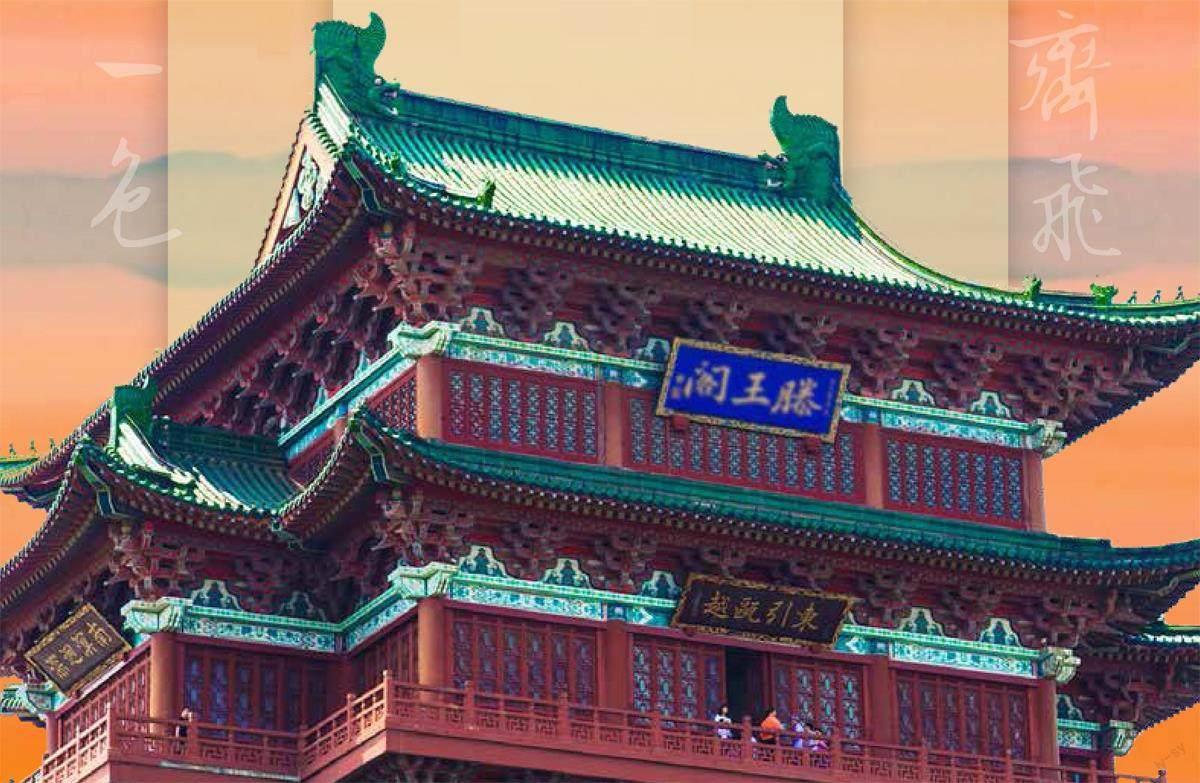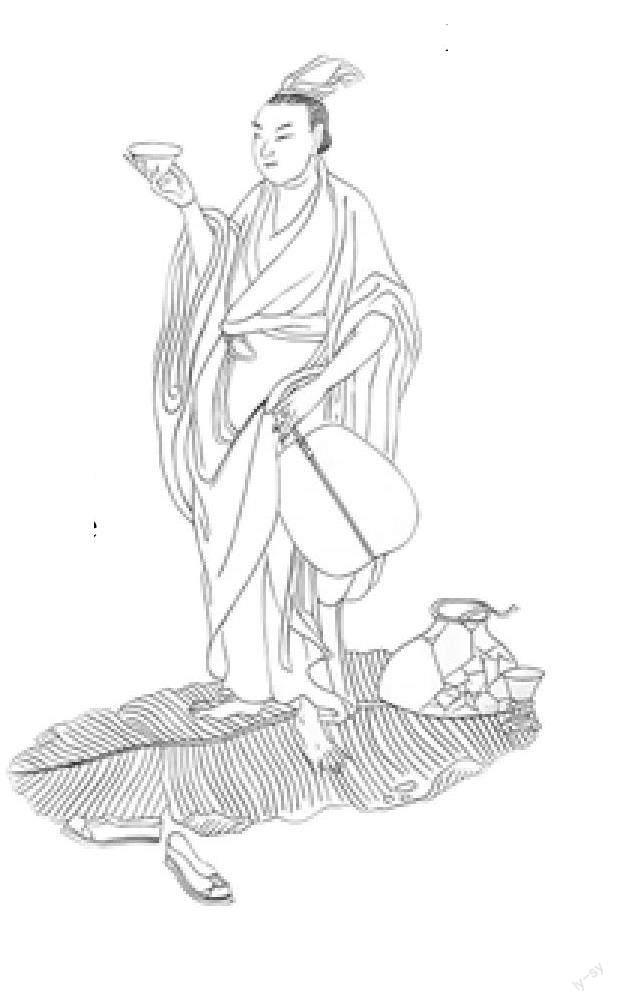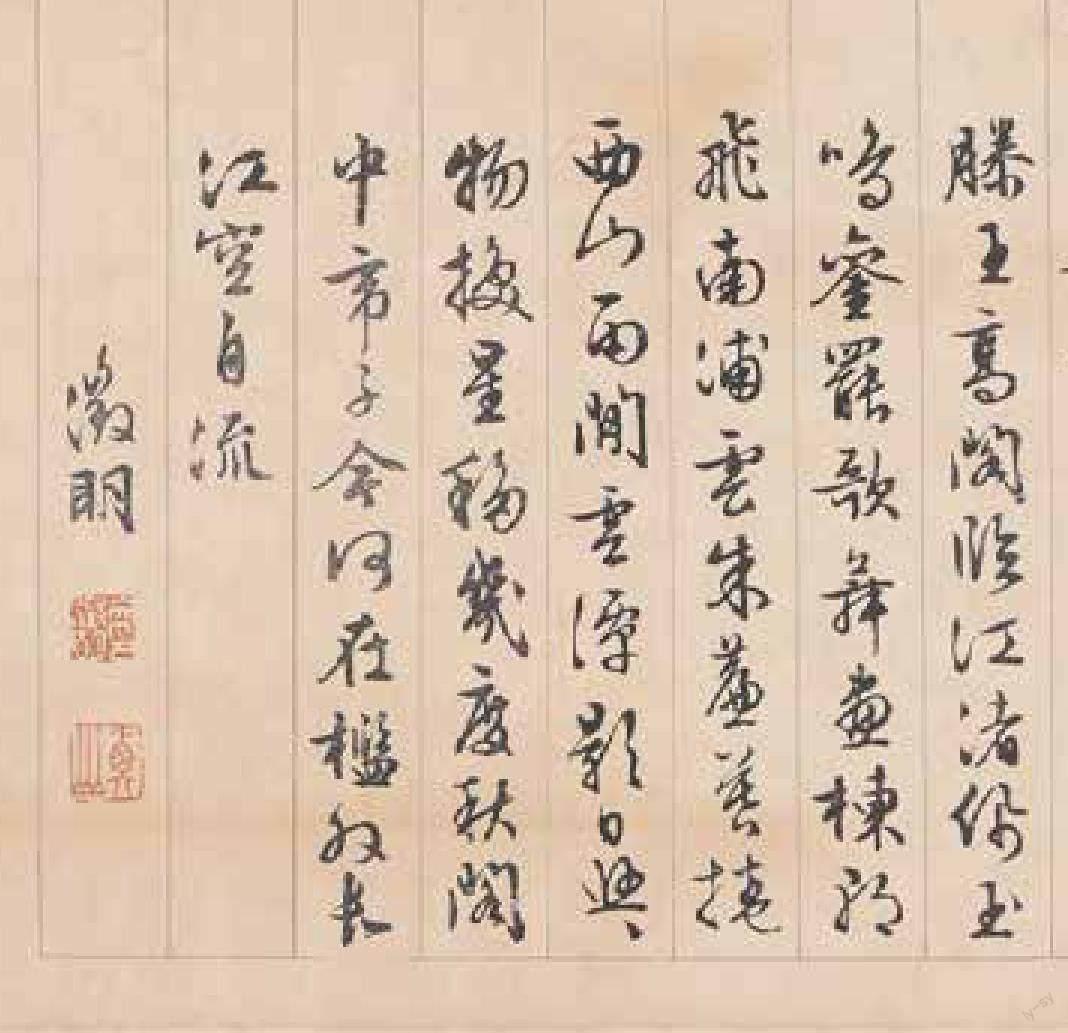滕王阁, 因王勃而不朽Wang Bo’s Literary Genius Elevates the Pavilion of Prince Teng to Fame
严夕寒



滕王阁位于江西省南昌市,是南昌市地标性建筑。它与湖南岳阳楼、湖北黄鹤楼并称为“江南三大名楼”。是什么原因使滕王阁名扬中外呢?
Located in Nanchang in Jiangxi Province, thePavilion of Prince Teng stands as a prominentlandmark. Known as one of the “Three GreatTowers of Southern China”, it shares this honorwith the Yueyang Tower in Hunan Province andthe Yellow Crane Tower in Hubei Province. Butwhat precisely gives the Pavilion of Prince Tengrenowned fame, both locally and globally?
滕王閣始建于公元653 年(唐永徽四年),为唐太宗李世民的弟弟李元婴所建。李元婴曾在山东滕州任职,故被世人称为“滕王”。后来李元婴调至洪州(现江西南昌)任都督。在洪州生活了多年的李元婴,因思念滕州,修建了这一建筑,并命名为“滕王阁”。
T he Pavilion of Prince Teng was first built in 653AD (the fourth year of the Yonghui calendar inthe Tang Dynasty) by Li Yuanying, the younger brotherof Emperor Taizong, Li Shimin. Li Yuanying spent hisearly years in Tengzhou, Shandong Province, earninghim the name “Prince Teng”. He was later appointedas the governor of Hongzhou (present-day Nanchang,Jiangxi). As nostalgia for Tengzhou gripped him, hedecided to manifest his longing by constructing thetower and named it the “Pavilion of Prince Teng”.
公元675 年(唐上元二年),时任洪州都督的阎伯屿重修了滕王阁,并在重阳节这天,在滕王阁大宴宾客,以此彰显自己的功绩。也就是在这一天,滕王阁的美名因为一个人的出现而流传千古。
Twenty years later, in 675 AD, the buildingwas refurbished under the helm of thenew governor, Yan Boyu. To commemoratethis event and flaunt his accomplishment,Yan threw a grand banquet at the Pavilionof Prince Teng on the Double Ninth Festival.This gathering would etch the pavilions namein history, all thanks to one individual.
那一天,一个身穿白衣、风度翩翩的少年出现在了阎都督的宴席之上。他就是唐代著名诗人王勃。王勃自幼就是个天才,六岁时便能写文章,且诗文构思巧妙。16 岁因科举及第而入朝为官。那一年,26 岁的王勃去探望远在交趾贬任县令的父亲,途经洪州,因他的才气在当时已为不少人知晓,故被邀出席了滕王阁宴会。
On that day, a young man of unassuming eleganceand a plain white dressing came to Governor Yansbanquet. He was Wang Bo, an eminent poet of theTang Dynasty. Wang Bo was a child prodigy, penningarticles from the tender age of six and showcasing exceptionalpoetic talent. By the age of sixteen, he hadalready aced the imperial examination, earning himan official post. During that year, while still in his earlytwenties, he was en route to visit his father, an officialserving in the south. His burgeoning reputationpreceded him, leading to an invitation to the banquetat the Pavilion of Prince Teng.
宴会上,阎都督假意请在场的才俊们即兴为滕王阁作序文。其实在宴会开始之前,阎都督已经让自己的女婿准备好了文章,想让他在宴会上一展身手,博得盛名。在场的人基本都知道阎都督的用意,所以都推辞不写。性情直率的王勃却并不在乎这些,他站起身,接过纸笔,说“我来试试”。见此情形,阎都督面露尴尬,但也不好拒绝,只好点头应允,心中有气又不好发作,于是便起身离开宴席,走进里屋。他吩咐下人去看王勃到底写了什么,随时把内容报告给他。
At the banquet, Governor Yan insincerely urged theassembled guests to spontaneously compose a tributefor the pavilion. In truth, he had already instructed hisson-in-law to prepare a piece beforehand, intendingto seize the spotlight and reap the fame. Sensing hisploy, many of the guests politely declined the challenge.However, the candid Wang Bo wasnt swayed bythese machinations. He stood up, picking up thepen and declaring, “Let me give it a try.” Despitethe embarrassment, Yan had no choice but toacquiesce, masking his annoyance by retreatinginto an inner chamber and ordering a servant toreport the content of Wang Bos writing to him.
當下人来报“豫章故郡,洪都新府”时,阎都督不屑道:“哼,不过是老生常谈罢了!”当下人再报“星分翼轸,地接衡庐”时,阎都督沉默不语,隐隐感觉这小子好像有点水平。当王勃写到“落霞与孤鹜齐飞,秋水共长天一色”, 下人再报时,阎都督忍不住赞叹道:“此真天才,当垂不朽!”
Upon hearing the first line, “Nanchang, the capitalof Yuzhang Commandery during the Han Dynasty, isnow the provincial center of Hongzhou,” Yan snorteddismissively, “Bah, just hackneyed old phrases.” Whenthe servant delivered the next verse, “It straddles theborder between the Ye and Zhen constellations andis located adjacent to Mount Heng and Mount Lu,”Yan fell silent, sensing the talent of the young man.However, it was the line, “The setting sun and thesolitary wild duck fly together, while the autumnwaters merge with the boundless sky”, that drew aninvoluntary exclamation from Yan, “Truly a genius,destined for immortality!”
滕王阁上,王勃文思滔滔不绝,一气呵成,写就千古绝唱《滕王阁序》,文惊四座。
As he sat in the pavilion, Wang Bos thoughtsflowed like a stream. He penned his immortal masterpiece“Preface to the Pavilion of Prince Teng” in asingle burst of creativity, leaving everyone awestruckby his talent.
《滕王阁序》开篇先介绍了滕王阁所处的地理位置, 接着远近结合对周边环境进行了描写,写出惊世名句“落霞与孤鹜齐飞,秋水共长天一色”。随后,王勃在文中表达了自己经历人生大起大落之后的感慨和自勉:虽时运不齐,命途多舛,但仍然穷且益坚,不坠青云之志。这番对人生和命途的感慨,使文章的立意更为深邃高远,由此造就了这“千古第一骈文”。
“Preface to the Pavilion of Prince Teng” starts bysketching the geographical location of the pavilion andthe surrounding milieu near and far. This gives birth tothe iconic verse, “The setting sun and the solitary wildduck fly together, while the autumn waters merge withthe boundless sky.” Furthermore, Wang Bo infuseshis reflections and self-motivation, born from hisown experience through lifes highs and lows. Despitethe buffets of fate and adverse circumstances, hisresolve stands firm, his ambitions undimmed. Theseintrospective musings on life and fate lend an extralayer of profundity to the piece, solidifying its status asa timeless classic.
《滕王阁序》全篇短短几百字,用了40 多处典故,创造了20 多个成语,如“天高地迥”“萍水相逢”“时运不济”“命途多舛”等,几乎每一个都沿用至今。令人惊叹的是,这一不朽之作是年轻的王勃未经事先相应准备,在当堂构思写就的。此后千百年的历史中,滕王阁便与王勃这个名字紧紧联系在了一起。
Although in just a few hundred words, “Prefaceto the Pavilion of Prince Teng” weaves in over fortyallusions and gives birth to more than twenty idiomaticexpressions, such as “the sky is high and the earth isdistant”, “chance encounters”, “adverse circumstances”,and “a turbulent destiny”. Almost all these phrasesremain in use even today. What is truly remarkable isthat this piece of poetry sprung forth spontaneouslyfrom the young Wang Bos mind, all in a single creativeoutburst. Since then, the name of Wang Bo has becomeinextricably linked with the Pavilion of Prince Teng,resonating through millennia.
根據《新唐书》记载,上元三年八月,王勃省亲返回渡南海时,不幸溺水,惊悸而亡。真是天妒英才!
Sadly, as mentioned in New Book of Tang, WangBo met a tragic end by drowning in the South Sea inAugust of the third year of Shangyuan calendar. It istruly disheartening to witness how the heavens oftenclaim individuals of remarkable talent prematurely.
王勃的生命虽然如惊鸿一般短暂,却如夏花一样绚烂。他就像一颗流星,在群星璀璨的盛唐一掠而过,但是他的光辉却闪耀了千余年。王勃的《滕王阁序》使滕王阁名声大噪,声贯古今。在千年的历史中,滕王阁饱经沧桑,屡遭毁坏,但屡毁屡建,先后重建了29 次。如若没有《滕王阁序》,滕王阁可能早就化为尘土淹没在历史长河之中了。如今去滕王阁游玩,如果谁能完整背诵《滕王阁序》,就可以免去门票自由参观,由此可见《滕王阁序》对于滕王阁的重要性。
Wang Bos life, though brief, is blazed withthe intensity of a sun-kissed bloom. Like ashooting star in the sky of the Tang Dynasty,his impact was felt far and wide and is stillrecognized today, even a thousand years later.His masterwork “Preface to the Pavilion ofPrince Teng” gave the pavilion a special placein history. The Pavilion of Prince Teng has seenmany changes over the years, being rebuilt 29times. But without the preface, it might havebeen forgotten long ago. Today, anyone whocan recite the preface is allowed to enter thepavilion for free, underscoring its enduringsignificance.
文以楼名,楼以文传。原本没有生命的建筑因文人墨客的惊鸿一笔,而被赋予了文化传承的意义。除了滕王阁,岳阳楼因为范仲淹的《岳阳楼记》声名远播,黄鹤楼也因为李白的《黄鹤楼送孟浩然之广陵》和崔颢的《黄鹤楼》闻名于世。这些千古名篇赋予了建筑生命,使之能够抵挡岁月的摧残;这些建筑也因为诗文的传承而历久弥新,让中华文脉和建筑文化得以延续,生生不息。
Buildings gain their fame through thewords written about them. These words breathelife into their structures and transform theminto enduring symbols of cultural heritage. Justlike the Pavilion of Prince Teng, the YueyangTower has achieved global recognition thanksto Fan Zhongyans “Memorial to the YueyangTower”. The Yellow Crane Tower is famousfor Li Bais “Bidding Farewell at Yellow CraneTower to Meng Haoran to Guangling” and CuiHaos “The Yellow Crane Tower”. These literaryworks bring these buildings to life, helpingthem survive through the ages. Through thesheer power of poetry, these architecturalmarvels not only preserve but also revitalizethe Chinese cultural and architectural legacy,ensuring their perpetual prosperity.

